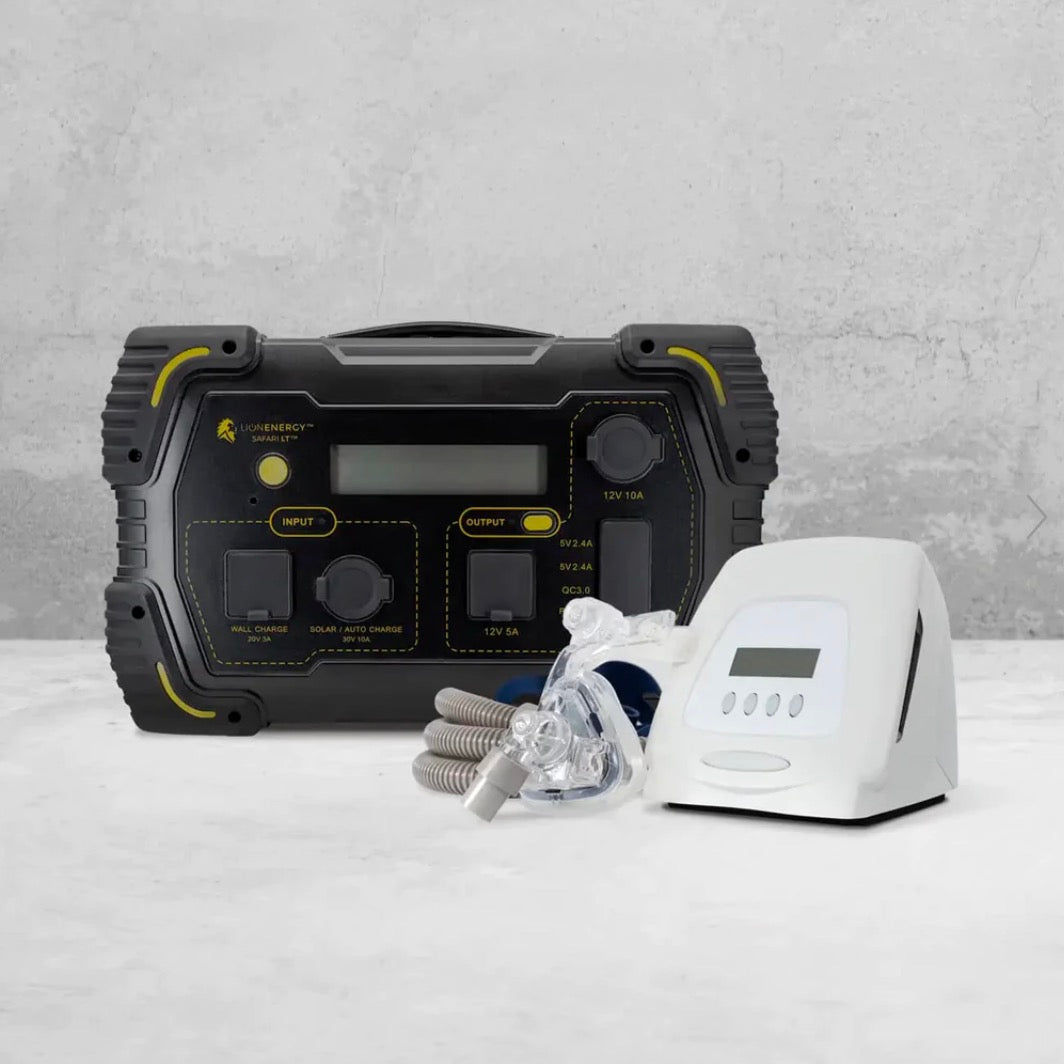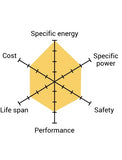White Paper by Tyler Stapleton and Thomas Tolman – July 2021
What can you power with the Safari LT
THE LION SAFARI LT
The Lion Safari LT is a 500W / 450Wh portable solar powered generator that provides safe, silent and renewable power for every day use so whether your cooking, camping, communicating, having back yard parties, entertaining, working or in an emergency, you"ll have the power you need.
SAFARI LT WHAT IT CAN POWER
Actual run times may vary

SAFARI LT OUTPUTS
Multiple outputs allow you to charge virtually any device.

Tech Specs
Tech Specs
|
Safari LT |
||
|
Weight (pounds) |
11 |
|
|
Dimensions - Inches (L x W x H) |
11.8 X 6.5 X 7.3 |
|
|
Output - AC |
2X 110V |
|
|
Output - USB |
2X USB-A 5V @ 2.4A |
|
|
1X USB-A QC 3.0 |
||
|
1X USB-C PD 60W |
||
|
Output - 12V |
1X 12V @ 10A |
|
|
Output - DC 12V |
4X 12V @ 5A barrel plugs (5.5mm x 2.1mm each) |
|
|
Warranty |
1 year |
|
|
Certification |
RoHS, FCC, CE |
|
Battery
|
Safari LT |
||
|
Battery Chemistry |
Lithium NMC |
|
|
Battery Capacity - Watt Hours (Wh) |
450Wh |
|
|
Battery Output - Watts (W) |
500W |
|
|
Life Cycles |
1,000+ |
|
|
Charge Retention |
Up to 1 Year |
|
Charge Rate
| Safari LT | |
|
Wall AC with provided Outlet/With Optional Fast Charger |
7 - 9 Hours/3.5 Hours |
|
Solar / DC Min. Charge Time (With 100W Solar Panel) |
5 - 7 Hours |







The Safari LT uses our Fast Charge technology so you can charge from solar in as little as 3.5 hrs. This gives you more power with less weight - 450Wh, 11 pounds. It can even power medical devices with its 500W pure sine wave inverter.
SAFARI LT BENEFITS

Fast Charge & Lightweight
Can fully charge from the wall in as little as 3.5 hours. At 11 lbs, it's light weight and easy to carry.
Safety
Made from Lithium NMC which is one of the safest tech on the market. You can use it indoors or outdoors. It produces no emissions.
Extended Use
Has 1,000+ lifecycles, which means you can use it over and over again. And it can hold a charge for up to 1 year.
Renewable Solar Generator
Renewable Solar Generator
Use the power of the sun to fully recharge the LT in just a few hours if using multiple solar panels.
Multiple Outlets
It has 2 AC outlets, USB-A, USB C, 4 barrels (12V), and a 12V Car auxiliary outlet. So the type of devices you can power is endless.
Built for Rugged Use
Heavy duty rubber mounted corners makes it ideal to take with you anywhere you go.
Pure Sine Wave
A 500W Pure Sine Wave inverter can be used to power medical devices like CPAP machines.
Silent
Produces virtually no noise, so you can sleep through the night at camp or have undisturbed work or play.
Environmentally Friendly
Produces zero emissions or carbon footprint during use. It's good for you and the planet.
HOW THE SAFARI LT STACKS UP TO OTHERS
- Compared to the other similar power stations in its class, the Safari LT is a much smaller, lighter, and has a rugged design.
- The Safari LT give you more outputs so you have more choices on powering your devices.
- Our Fast Charge technology makes it so you are able to charge the LT faster and get on to your adventures sooner.
- When comparing power capacity on a price per unit, the Safari LT gives you the most bang for its buck.
Want to recharge the LT off grid? SAFARI LT ULTIMATE KIT
Being away from your house doesn't mean you have to leave your power behind. Take power with you with the Lion Ultimate LT Kit. It provides safe, silent, renewable, portable power using the energy of the sun.
-

1 x Lion Safari LT2 x 100 Watt Folding Solar Panel1 x 25' Anderson Cable1 x Fast Charger for the Safari LT
Lion Energy Safari LT Frequently Asked Questions
Lion Energy Safari LT Frequently Asked Questions
What is the Safari LT?
The Safari LT is the latest in Lithium technology for portable power needs. It replaces traditional noisy gas generators with the safest Lithium batteries on the market today. It is lightweight and powerful solar power unit.
What does the Safari LT power?
You can use it to power a wide variety of devices like cell phones, laptops, tablets, mini-fridges, TV's lights, power tools, and the list goes on. Any device that requires less than 500 watts, the Safari LT can power it.
How can you figure out how long the Safari LT will power specific devices?
To calculate how long the Safari LT can power a device, use this formula: Wh / W = Estimated Run Time. The Safari LT has a continuous 450Wh of power output. For example, if your device draws 25 watts then the LT would power the device for 18 hours (450Wh/25W=18hours).
How long can the Safari LT hold a charge?
It will maintain its charge for up to a year without having to charge it. This is known as shelf life or storage life. However, we recommend using it more frequently – in the house, outside, on adventures and ready for emergencies. It has over 1,000 cycle capacity so you can use it again and again and again.
Can it store solar power?
The Safari LT is a great energy storage unit for solar power and can be charged by using solar panels. It can store 450Wh (Watt hours).
What is in the box?
The Safari LT, User Manual, Wall charger adapter (5V@3.4A). If you also purchase the Safari LT directly from Lion Energy Online it comes with our fast charger.
Why should I buy Safari LT?
The Safari LT is made from the highest quality and longest lasting battery technology - Lithium. The Safari LT is safe, silent and renewable, unlike other gas-powered generators. It gives you power anywhere, anytime.
How do I get the AC output on the Safari LT to turn on?
The AC power on the Safari LT is not automatically turned on when you plug something into it. First turn on the main Safari LT unit then press and hold the yellow AC power button on the side located by the 2 AC plugs for 2-3 seconds. The red indicator light on the AC button will be illuminated.
How do I charge my USB, 12V Devices?
Once you turn on the main Safari LT unit, turn on the USB, 12V, or the 4 DC 12V barrel output by pressing the yellow Power Indicator button in the output area on the front of the Safari LT device for 2-3 seconds.
Is it good in bad weather?
The Safari LT perform great in most weather conditions. It is water resistant but not waterproof.
How big is the Safari LT?
It weighs in at only 11 pounds and is 12" L X 6.5" W X 7.3"
What's the rated capacity?
It is a 12V, 450Wh (watt hours or how much energy it can store), 500W (watts or how much power it can output at a time).
How do I recharge it?
The Safari LT is part of Lion Energy's pride of products that creates clean, limitless, renewable energy sources to power your life. It's designed for recharge through traditional AC power or renewable source - the sun.
It is loud?
Unlike other power units, the Safari LT has silent power enabling you to sleep through the night at camp or allowing for an undisturbed work environment. The Safari LT uses a lithium battery and powerful inverter. Occasionally a small internal fan may to turn to cool the unit.
How long will it last?
The Safari LT can last for years if you take care of it and it comes with a 1 year warranty.
Can you power multiple devices at the same time?
You can use all the outputs at the same time. So, that is two devices charging off the USB Ports, another device charging off the cigarette light, another device running off the AC 110V plug (this could be a 60 inch T.V.) and another device charing on the USB C.
Do I have to maintain the Safari LT?
The Safari LT is virtually maintenance free. It can be used on a daily basis
What is a USB-C?
This is the charging port that all the new phones are using. All Android phones will be switching to this type of plug. They will do this because it is able to handle more power. Lion Energy added this port so that the Safari LT is on the leading edge of technology.
Lion Energy Policy
Lion Energy Return, Cancellation & Refund Policy
Lion Energy 5-Year Warranty
This Warranty Disclaimer ("Disclaimer") sets forth the terms and conditions governing the warranty coverage provided by Lion Energy ("we," "our," or "us") for designated products sold or distributed by us.
- Warranty Coverage:
We provide a limited warranty that covers factory defects in materials and workmanship ("Defects") for a period of 5 years from the date of purchase ("Warranty Period"). This warranty is applicable only to the original purchaser of the product ("Buyer"). - Exclusions:
This warranty does not cover normal wear and tear resulting from regular use of the product. Normal wear and tear include, but are not limited to, scratches, dents, fading, discoloration, or any other deterioration that occurs through customary use of the product. Additionally, this warranty does not cover damages caused by improper handling, misuse, neglect, accidents, modifications, or any unauthorized repairs or alterations made to the product. - Warranty Claims and Remedies:
If the product exhibits a Defect during the Warranty Period, the Buyer must promptly notify us and provide proof of purchase. We, at our discretion, will either repair or replace the defective product, subject to the terms and conditions of this Disclaimer. Any repaired or replaced product shall be covered by this warranty for the remaining Warranty Period or thirty (30) days, whichever is longer. - Limitations of Liability:
TO THE MAXIMUM EXTENT PERMITTED BY APPLICABLE LAW, WE DISCLAIM ALL OTHER WARRANTIES, WHETHER EXPRESS OR IMPLIED, INCLUDING BUT NOT LIMITED TO MERCHANTABILITY, FITNESS FOR A PARTICULAR PURPOSE, AND NON-INFRINGEMENT. WE SHALL NOT BE LIABLE FOR ANY INDIRECT, INCIDENTAL, SPECIAL, CONSEQUENTIAL, OR PUNITIVE DAMAGES ARISING OUT OF OR RELATED TO THE PRODUCT, INCLUDING WITHOUT LIMITATION, LOST PROFITS, LOST REVENUE, LOSS OF USE, OR COSTS OF SUBSTITUTE GOODS, EVEN IF ADVISED OF THE POSSIBILITY OF SUCH DAMAGES. - Governing Law:
This Disclaimer shall be governed by and construed in accordance with the laws of Utah, USA. Any disputes arising under or in connection with this Disclaimer shall be subject to the exclusive jurisdiction of the courts located in Utah, USA.
By purchasing or using our product, the Buyer acknowledges and agrees to be bound by the terms and conditions of this Warranty Disclaimer.











 PRODUCT DESCRIPTION
PRODUCT DESCRIPTION


